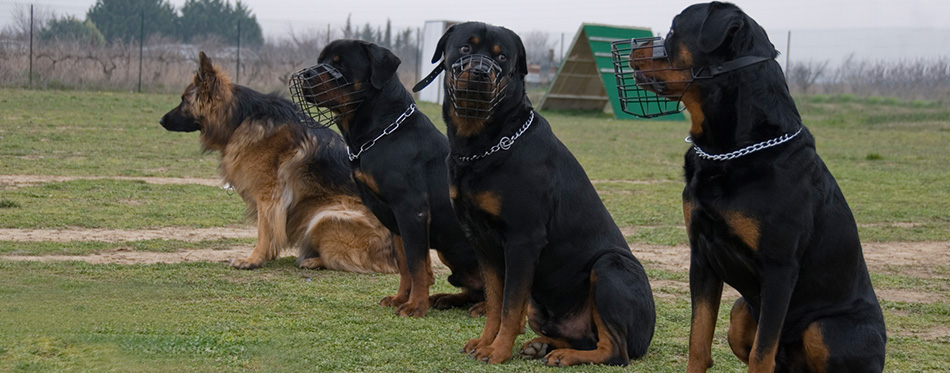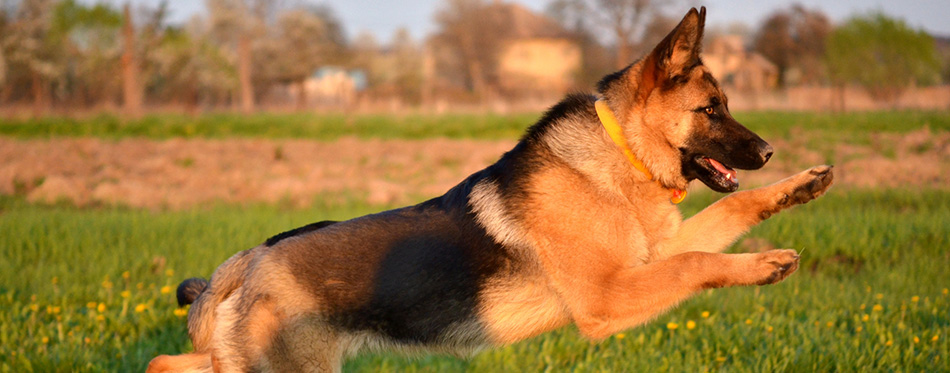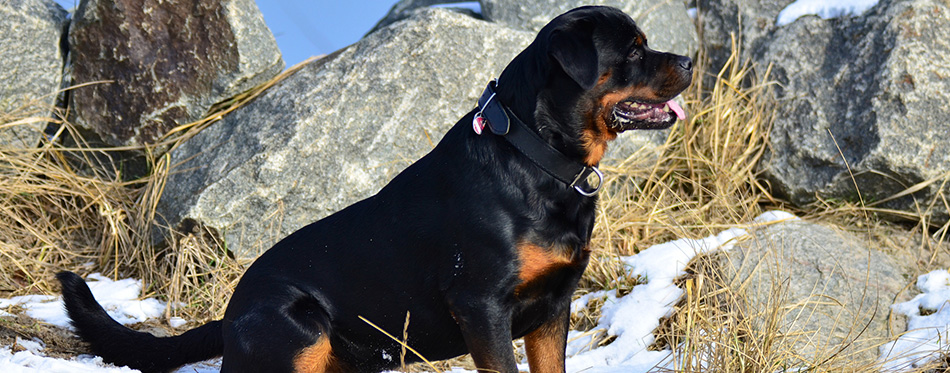A combo of the noble German Shepherd and powerful Rottweiler, the Shepweiler brings together the best of both worlds. This large and gorgeous breed is strong, smart, loving and relatively easy to train, making it a perfect guard dog, as well as a family companion. Whether you’re thinking of purchasing a Shottie puppy, or you already own an adult Rottweiler Shepherd, this article is for you. Here, we cover everything you need to know about this new designer mix breed, including important things about its health and temperament, diet, grooming needs, and so much more!

History of the Shepweiler
We tried looking for the most credible source of the history of the Shepweiler, but the only data that we found points to the early 2000s as its most likely period of creation. We have to emphasize “most likely” since majority of the designer dog breeds have been created sometime in the 1980s with a few as far back as the 1950s and 1960s.
Mixing two different breeds of dogs to create a new one is not really a new concept. Even the German Shepherd is known to be a mixture of several ancient dog breeds. However, it is also important to point out that the popularity of designer dogs started to peak in the 1990s. By the new millennium, Hollywood A-listers, socialites, and artists were already showing their designer dogs as part of the new culture of dog owners. While owners of purebred dogs still outnumber pet parents of designer breeds, we cannot deny the fact that more and more people are going for hybrid dogs like the Shepweiler.
Crossing two purebreds is the only way one can ensure the best possible combination of traits expected in a particular hybrid. Generally, breeders will start with a base purebred and study its unique characteristics. They will then look for another purebred that will help negate the perceived shortcomings of the base breed or will further enhance its desired characteristics.
We can only guess that the reason behind the creation of the Shepweiler has more to do with combining the strengths of both the German Shepherd and the Rottweiler. Why? Well, one of the fundamental reasons why breeders will cross one dog with another is to create a low-shedding dog. The German Shepherd is a heavy shedder, but interestingly, so is the Rottweiler. If the intention of the breeder was to create a low shedding dog, they would have used a Poodle instead of a Rottweiler.
So, why would someone cross a GSD with a Rottweiler? The answer seems to be pretty obvious – to create a very loyal, brave, and intelligent dog that is both a great family pet and an intimidating guard dog. That being said, we cannot claim with certainty that this was the reason behind the Shepweiler’s creation as its origin story is far from clear-cut. Nevertheless, there’s no denying that this is one of the bravest, strongest and easiest to train breeds out there!
Who are the Parents?
We can only speculate as to why the Shepweiler was created, but if there’s one thing we can be certain of, it’s that this hybrid is the result of breeding two of the world’s most venerable guard dogs – the Rottweiler and the German Shepherd.
German Shepherd
The modern German Shepherd owes its creation to the pioneering efforts of Max von Stephanitz in the 1890s. Let us just say that, without Stephanitz’s single-minded determination to create what he believed to be the epitome of a German Shepherd, we wouldn’t have a dog that is one of the most versatile breeds in human and canine history today.
Known and highly-valued for its sheer intelligence (in case you didn’t know, the GSD is the canine world’s 3rd most intelligent breed!), beauty, speed, strength, and highly acute sense of smell, the German Shepherd is both a well-loved and feared hound. Families love the companionship it provides, the protection it guarantees, and the affection it shows for their children. Unscrupulous individuals and wrong-doers fear it, fully knowing that they are no match against the strength, cunning, agility, and sheer bite force of a raging German Shepherd. They know that it will be like coming face-to-face with the vaunted German Tiger tank of the Second World War when all you have is a flimsy Sherman.
When it comes to its sense of duty, no other dog breed can be as devoted as the German Shepherd. As long as it is trained dutifully, it can readily accomplish any task and perform any role. Its tenacity as a herding dog has been expanded into other areas as well. Its curious and intelligent nature makes it a highly prized companion of bomb experts and contraband detectors as well as fugitive hunters. It may not be a scenthound, but it has the many fine qualities of a Bloodhound.
While its fearsome reputation among wrong-doers is remarkable, its gentleness is revered among those who need some form of assistance. GSDs can be easily trained to be the eyes and ears and even the arms and legs of those who no longer have such faculties. Their mild temperament can also soothe the wounded soul while providing comfort for those who are longing for the unquestionable friendship, loyalty, and devotion.
Because of its intelligent and active nature, the GSD is not for everyone. It requires someone who is both attentive and physically active. This dog thrives in an environment where it can harness its true potential.
Rottweiler
The Rottweiler has got to be one of the most misunderstood, if not most maligned, breeds in the dog kingdom. Together with the American Pitbull Terrier, the Rottweiler has always been depicted as ferocious having been cited in many dog attacks. However, in most cases, dog attacks are a result of poor pet ownership.
Regardless of what you hear and see in the media or how this breed is portrayed in Hollywood films, the Rottweiler is a placid, gentle, and mild-tempered dog when properly trained and socialized. Its devotion to its family is unparalleled, perhaps even stronger than the German Shepherd’s. It has a self-assured and steady personality that is often interpreted by people who don’t know the breed as arrogant and aggressive.
The devotion of the Rottweiler is never unfounded. Bred by the ancient Roman army to go with them as they expanded the Empire, Rotties were tasked with the driving of the army’s livestock from one battlefield to the next. They would cross treacherous terrain driving cattle, sheep, and other livestock that served as the army’s sustenance throughout their expedition. At night, when all the soldiers would go to sleep except for a handful of sentries, Rotties would stand guard to fend off attacks by both thieves and ferocious animals like wolves and bears. Rotties instinctually understand that their owners and their property rely on them for guardianship and protection; a task they do so with devotion.
When the people of ancient Rome brought their livestock to the market, they depended on the Rottweiler to drive and protect cattle and sheep throughout the risky journey. It is this unquestionable devotion and commitment to guarding livestock and their human masters that has earned the Rottweiler the badge of courage from those who really know it well.
Today, Rottweilers are no longer guarding and driving livestock. Instead, they have found new roles to play. Like the German Shepherd, many Rotties today are employed as police dogs, guard dogs, and even as members of search and rescue units. Some are also trained as therapy dogs, a role that can have some people raising their eyebrows given the dog’s media-painted reputation for aggression.
Rottweilers, like German Shepherds, are not for the faint of heart. They are also not for dog owners who employ harsh training methods and who strongly believe in the use of punishment as a means to instill discipline in the dogs. It is important to remember that punishing the dog doesn’t instill discipline; it just strikes fear. You don’t want a fearful dog because fear can be a mighty fuel for aggression.
Quick Facts
We may not know who ‘designed’ the Shepweiler or where it was created or even when this happened. What we do know is that it is a very lovable hybrid and one that you shouldn’t miss. However, since there will always be unscrupulous breeders offering you what they call the true German Shepherd Rottweiler mix, you’d better be ready with these quick facts to help you discern the real from the fake.
- Shepweilers are also known as the Rottweiler Shepherd, Rottie Shepherd, Shottie, and Rotten Shepherd, although we beg you not to use the last one!
- At the very minimum, a Shottie should be 22 inches tall, especially for females. It can grow up to 27 inches however, and sometimes even more than this.
- On average, a Shepweiler can live up to 12 years, topping at 13 with the minimum at 10.
- It is a heavyweight hybrid, typically weighing in at a minimum of 75 lbs and a maximum of 115 lbs.
- Its body should always be muscular and with a powerful jaw. The legs are long and the feet are large.
- Its coat can be moderate in density and can be of short to medium length. The coat is straight, however, not wiry, curly, corded, or even wavy.
- The GSD is a heavy shedder. The Rottweiler, on the hand, also sheds but not as heavily as the GSD. This is despite the fact that it has short hair. You can, thus, expect the Shepweiler to be a moderate shedder.

Things You Should Know
Whether you’re considering getting a Shepweiler or you already own one, here are some important things to know about this gorgeous and formidable breed.
Training
The Shepweiler is very easy to train; that is, if you know what you’re doing and you have the personality of a true pack leader. You see, both the Rottweiler and the German Shepherd have become so proficient at what they do simply because they got the best training. Mind you, these are smart dogs that know what they want and can easily pick up the scent of a wannabe dog trainer from a real seasoned handler. They know if you’re just pretending to be its master. They also know if they can push their luck and test your limits. This is where the majority of dog owners fail. They easily snap. They don’t have the patience and perseverance to train their dogs, let alone a mix of two of the most revered breeds on the planet.
Training the Shepweiler shouldn’t be difficult, but only if you start it as young as 6 weeks old. The puppy doesn’t need to go to advanced dog obedience training right away. Housebreaking is important as this establishes the ground rules you and the dog will be following in the house. Potty training and crate training are equally important. Learning basic dog obedience commands like ‘come’ and ‘sit’ are crucial in many dog-related activities specially when going outdoors.
Feeding
Shepweilers are mighty large dogs. Unfortunately, they are quite prone to gastric dilatation volvulus as well as obesity. You don’t want a fat Shepweiler; you want it to be beefy muscular. As such, it is imperative that you learn just how much calories the Shepweiler will require, factoring its weight, age, activity level, life stage, and a few other factors.
A typical 90-lb Shepweiler will require about 1,800 to 2,200 calories per day. The usual feeding recommendation for dogs is twice a day. For the Shepweiler, however, more frequent feedings is generally more appropriate considering that it is quite prone to gastric dilatation volvulus or bloat. So, feeding it 3 to 4 times a day is better than once or twice daily feeding. This means you will need to give about 600 to 735 calories per meal if you decide to feed it 3 times daily. That’s 450 to 550 calories per meal if 4 times a day.
Stick to high-quality, protein-rich dog food with animal proteins as the main ingredient. You can give fruits and veggies as treats, but make sure to steer clear of grapes, apples, and other food items that may be dangerous for dogs. Also, skip the allergenic grains such as wheat, soy, and corn. Don’t forget to consider chondroitin and glucosamine for its joints.
Check out our guides on Wet Dog Food and Dry Dog Food for more info.
Exercise
The Shepweiler is a muscular hybrid. That alone should give you an idea of its activity levels. After all, you don’t get that much muscle if you’re a couch potato! That being said, a Shepweiler expects its owner to take it for really long walks that should last at least 60 minutes, ideally two times a day. Now, if you don’t have the time to walk, then you can go on a 30-minute jog or a half-hour bike ride with the Shepweiler running along.
Regular exercise is a must for all dogs, more so for the Shepweiler. This is not only to make sure that it is able to maintain its robust physique but also to keep canine boredom at bay. Alternatively, they can be allowed to play vigorously in a wide-open backyard with high-enough fencing so they don’t venture into your neighbor’s property.
Socialization
There’s no doubt that the Shepweiler is a very friendly dog, but only if you care enough to introduce it to as many pets and people as a puppy. Both its parents, the GSD and the Rottweiler, do not easily make friends with strangers. They are not the Golden Retriever who simply cannot distinguish a stranger from a family member (for the Golden, everyone is a friend).
Shepweiler’s parents treat strangers with caution. The Shepweiler will never show its teeth or even let out a faint growl, but you cannot also expect it to wag its tail and get comfy and cozy with a newcomer. It will stand its ground, throwing furtive glances at a stranger trying to figure out if this person is a friend or not. You really cannot blame the hybrid. Its parents were bred that way, especially the Rottweiler. It is especially suspicious of anyone and anything that is not a member of its ‘flock’.
Early socialization can address many of these issues. Puppies do exceptionally well if they grow up interacting with other animals in the household. The same is true with humans. The earlier they get to interact with different types of people, the better and more social they become when they grow old.
Grooming
When it comes to grooming, everything depends on whose trait is more dominant in the Shepweiler. If it is the Rottweiler, then you can expect less frequent brushing and combing of the coat since it will be relatively short. But if you have a Shepweiler with a more dominant GSD coat pattern, then you can expect combing and brushing at least 3 times a week. It will also shed a lot more so get ready with a vacuum cleaner or at least a de-shedding tool.
Related Posts: Dyson Pet Vacuum and Vacuums for Pet Hair
Bathing is not necessary unless your pet’s coat is obviously dirty. Once or twice a year bathing is often enough. If there is a grooming routine that should be performed every single day, that would be brushing the teeth. Unfortunately, it is very rare to find a pet parent who can really adhere to providing daily dental care for their dog. If this is you, try to stick to brushing your dog’s teeth at least once or twice a week. Clipping the Shepweiler’s nails and cleaning its ears can be done once every 2 to 3 weeks.
You may find the following dog grooming guides interesting: dog shedding brush, dog grooming gloves, dog toothpaste and dog toothbrush.

Health
Elbow and hip dysplasia are quite common among Shepweilers. Their weight alone can exert undue stress on their joints, making them at an increased risk for arthritis and other joint problems. This breed is quite deep-chested, too, making bloat a considerable risk. Other health concerns can include hypothyroidism, skin problems, cancer, and autoimmune diseases, among others.
Temperament
A well-trained, well-socialized Shepweiler has a very gentle and amiable temperament. It can be as mild-mannered as a Labrador Retriever and calm, affectionate, and gentle as a Maltese. It also takes on the obedient, loyal, intelligent, courageous, and confident nature of its parents. Its loyalty can sometimes be faulted. It can readily sense if its family is in danger and will do anything in its power to protect its family. Its devotion can never be questioned.
We’d definitely advise you to bring home a German Shepherd Rottweiler mix if you…
- Already have experience training and socializing either a GSD or a Rottweiler
- Have a house with a spacious backyard or access to wide-open spaces
- Can teach your young kids how to properly care for such a dog
- Don’t mind cleaning up your house after heavy shedding
- Love to exercise and play outdoor games
Unfortunately, we don’t think the Shepweiler is best suited for you if you…
- Have no clue as to what positive reinforcement means
- Intend to give your dog the cheapest dog food you can find
- Have been diagnosed with a pet allergy
Regardless of how intimidating the Shepweiler may look, in the hands of a responsible pet parent, it can easily become the sweetheart of the family and the darling of the crowd. The question we have for you now is if you are prepared to be the Shepweiler’s responsible pet parent. If your answer to this is in the affirmative, then you’re more than ready to bring home a beautiful German Shepherd Rottweiler mix.
Source:
- The German Shepherd Rottweiler Mix – Breed Guide – Animal Corner

